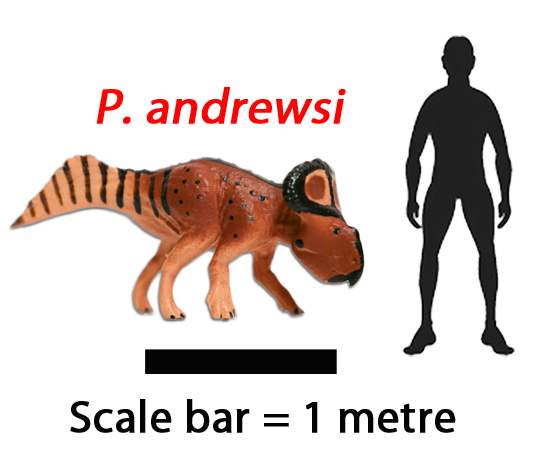Protoceratops Lived in a “Stressed” Environment
Everything Dinosaur team members are currently putting together a short video review of the new Wild Past Protoceratops (P. andrewsi) dinosaur model. Our intention in the video is to discuss the model and also to talk about the genus upon which the figure is based. After all, Protoceratops is one of the most studied of all the dinosaur genera known to science. However, “first horned face” can still throw up a few surprises. For example, the size of its orbit (eye socket), suggests the Protoceratops had disproportionately large eyes compared to other ceratopsians. Could Protoceratops have been nocturnal?
Protoceratops andrewsi
Size Comparison (Protoceratops andrewsi)

Picture credit: Everything Dinosaur
Protoceratops was a Tough Dinosaur!
Intriguingly, when the dinosaur fossil specimens collected by the Central Asiatic Expeditions from 1922-1925 (the expeditions led by Roy Chapman Andrews and Walter Granger of the American Museum of Natural History), from the Flaming Cliffs locality are totted up, over 90 percent of them represent Protoceratops andrewsi.
The Flaming Cliffs are the type locality for the Djadokhta Formation. Something like 108 individual dinosaur specimens were collected by the American Museum of Natural History field teams between 1922 and 1925, all but seven of them represented Protoceratops andrewsi. Preservational bias has been largely ruled out, it is therefore likely that Protoceratops was common in this habitat. However, both the Djadokhta Formation and the potentially contemporaneous Bayan Mandahu Formation, where the fossils of the second Protoceratops genus were found (P. hellenikorhinus), represent arid, desert-like palaeoenvironments.
Both Protoceratops species lived in extremely harsh conditions, an idea supported by the lack of diversity and the absence of large animals from the fossil record of both Djadokhta and Bayan Mandahu.
A Lack of Diversity and Few Large-bodied Dinosaurs Associated with Bayn Dzak (Flaming Cliffs Type Locality) of the Djadokhta Formation

Picture credit: Everything Dinosaur
Comparing the Djadokhta Formation and the Nemegt Formation Dinosaur Biotas
The lack of large-bodied dinosaurs and the limited number of different types of dinosaur are highlighted when these geological formations are compared to the Nemegt Formation dinosaur biota. The strata that forms the Nemegt Formation was formed in a much wetter more verdant environment.
Hadrosaurs, Titanosaurs, Ankylosaurids and Large Theropods Dominate the Nemegt Formation Dinosaur Biota

Picture credit: Everything Dinosaur
The Everything Dinosaur website: Everything Dinosaur.
The lack of diversity and the absence of large-bodied vertebrates from the Bayn Dzak location indicates that Protoceratops inhabited a stressed environment. Protoceratopsid fauna is associated with sediments from semi-arid, to desert regions formed from aeolian deposits in the main. During the time that the Djadokhta and the Bayan Mandahu Formations were being formed, much of central Asia was characterised by an extensive sandy desert with little surface water.
Protoceratops may have been quite small, but it was a very tough and hardy dinosaur.
To see the article that features an early Wild Past Protoceratops dinosaur model video made by Everything Dinosaur: Wild Past Protoceratops Video Showcase.
To purchase the Wild Past Protoceratops figure: Wild Past Protoceratops dinosaur model.






Leave A Comment